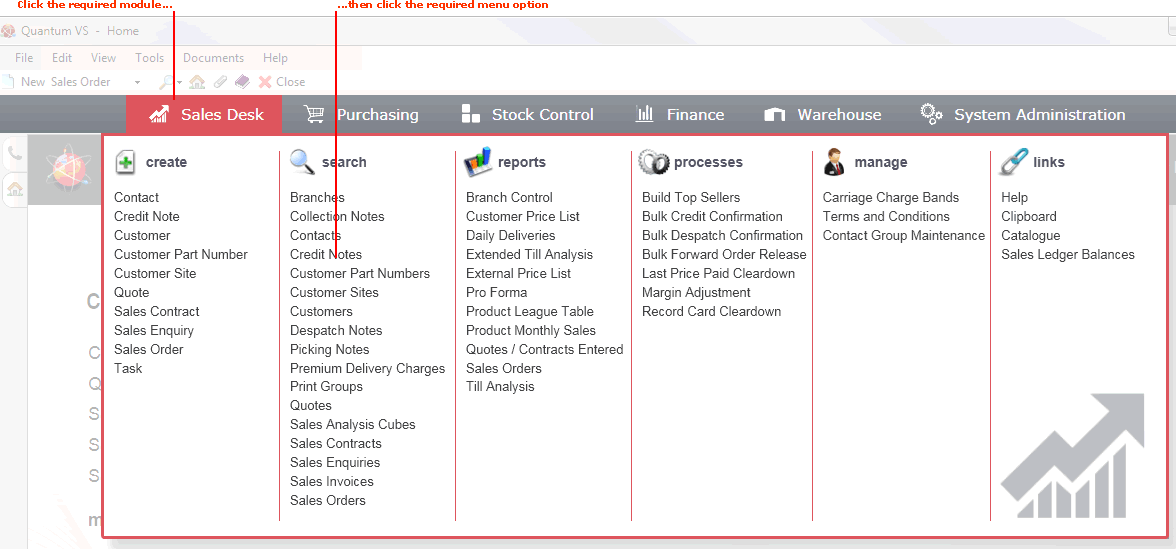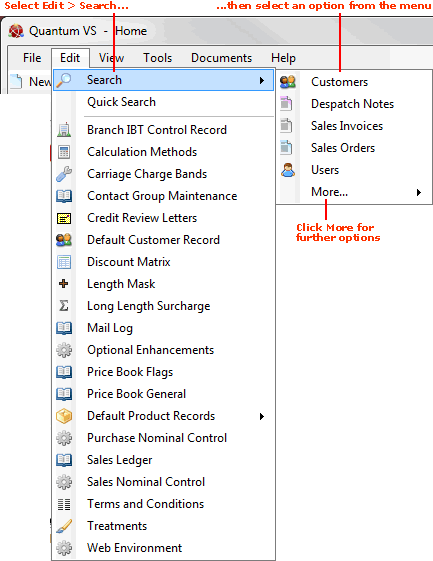Finding Product Inventory Records
You may use the Finder to:
-
show details of your Product Inventory records;
-
locate a specific Product Inventory record; and
-
open a Product Inventory record for viewing/editing.
Note: Rather than using your mouse, it is possible to use your keyboard to activate the required record type in the Finder, browse records in the Finder, then open the record in a new tab or add it to an open document. See Using Keyboard Shortcuts With The Finder.
Displaying Product Inventory Records In The Finder
To show Product Inventory records in the Finder:
-
From the Home tab: under search, select Product Inventory.
-
Or: Use the search section in the Mega Menu to select Product Inventory.
-
Or: From the main menu: select Edit > Search, then select Product Inventory.
-
Or: In the Finder: click the 'down' arrow on the Search... button and select Product Inventory from the menu.
Your Product Inventory records will be listed in the Finder. For example:

For further details and column definitions see Viewing Product Inventory Records and Product Batch Traceability Maintenance.
Note: You may change the sequence of records displayed - see Changing The Search Sequence.
Browsing Product Inventory Records
If more than one page of records is displayed in the Finder you may click the blue arrow keys on the Finder Toolbar to scroll through pages of records and/or enter/select a page number. For example, entering 40 will show the 40th page of results. See Browsing Records in The Finder.
You may select the Branch which created the Product Inventory record using the Branch menu on the Finder Toolbar.
Opening A Product Inventory Record From The Finder
To open the required record from the Finder, either:
-
Click the Batch Number or Bin Location hyperlink of the record you wish to open.
-
Or: Right-click on the line of the record, then select the View... option.
The record will open in a new tab. For further details see Viewing Product Inventory Records.
Other Available Hyperlinks
The following hyperlinks are also available in this Finder. Click:
Changing The Sequence
You may wish to alter the sequence in which the records are displayed in the Finder. To do this:
1. Click Advanced on the Finder Toolbar.
2. The Search menu shows the current order in which records are displayed. To change the sequence, select an alternative option from the menu.
Product Inventory records have the following Search options:
-
Product Code: Display Product Inventory records (and search results) in Product code order.
-
Product Record: See 'Product Code' Versus 'Product Record' Sequence Options.
-
Bin Location: Display Product Inventory records (and search results) in Bin Location order.
-
Batch Number: Display Product Inventory records (and search results) in Batch Number order.
-
Receipt Date: Display Product Inventory records (and search results) in Receipt Date order.
You may also change the sort order by selecting either A to Z or Z to A.
3. Click the search (magnifying glass) icon  on the Finder toolbar. The records will be re-sequenced.
on the Finder toolbar. The records will be re-sequenced.
Searching For A Specific Record
To find a specific record without having to browse through pages of records:
1. Type an appropriate search term into the search field on the Finder Toolbar.
The search term you enter should relate to the Search option selected - see above. For example, if the Search option is Product Code then enter all or part of the number of the Product code associated with the Product Inventory record.
Note: You may click the down arrow within the Search field to view and select a recent search.
2. Click the search (magnifying glass) icon  on the Finder toolbar.
on the Finder toolbar.
The records will be re-sequenced in the Finder, with the nearest matching record displayed at the top.
Filtering Product Inventory Records
You may use filters to control which records are displayed in the Finder. To filter Product Inventory records:
1. Click Advanced on the Finder Toolbar.
2. By default, Product Inventory records of every Status are displayed in the results (i.e. all of the Status fields are checked). To reduce the number of results you may wish to uncheck the following fields:
-
All: Show Product Inventory records of every Status
-
Available: Show Product Inventory records with the Status 'Available' (i.e. available to be sold)
-
Automatic Hold: Show Product Inventory records with the Status 'Automatic Hold' (i.e. automatically held for inspection)
-
Manual Hold: Show Product Inventory records with the Status 'Manual Hold' (i.e. manually held for inspection)
-
Fully Allocated: Show Product Inventory records with the Status 'Fully Allocated' (i.e. all stock has been allocated to Sales Orders)
-
In Transit: Show Product Inventory records with the Status 'In Transit'
-
Used: Show Product Inventory records with the Status 'Used' (i.e. there is no stock left)
3. Click the search (magnifying glass) icon  on the Finder toolbar.
on the Finder toolbar.
The selected records will be displayed in the Finder.
Note: To list all records again: check the All field then click the search (magnifying glass) icon  on the Finder toolbar.
on the Finder toolbar.
NEXT: Finding Purchase Order Lines




